 A beautiful goldsmith’s daughter
A beautiful goldsmith’s daughter
Once upon a time, there lived a goldsmith in a tenement house on Złota Street 4. He had a beautiful daughter Helena (or maybe Teresa). The girl of a great beauty had many admirers among both young and elder men. She was also the apple of daddy’s eye, who would do everything for his daughter. The father was deaf to the rumors brought by local women who constantly reported on the shameless conduct of the girl. Indeed, many adorers during the nightly trysts entered through one gate and left through another one, thus, they did not meet each other. The only witness of the nightly trysts was the cockerel on the Trinity Tower, which, till today, crows when a faithful man passes through the gate.
 Black Inez
Black Inez
This legend is associated with a famous Lublin executioner, who was highly esteemed among the inhabitants of Lublin. It was him who, in the building on Rybna Street gifted to him for his contributions, founded a bawdy house. This place was full of music, laughter and merriment. There were also many beautiful women from around the world coming there. Once, there arrived a pretty girl with black hair. She was an extraordinary dancer, who was given the nickname ‘black Inez.’ The girl captured all the men’s hearts, also a cold heart of the executioner. Despite the requests to be his chosen one, she kept on refusing. One time, in a flush of despair, the executioner killed the dancer. After that, he was wandering around through the streets of Lublin, calling his Inez. Eventually, he disappeared. Residents of Rybna Street admit that sometimes at night it is possible to meet a strange couple affectionately hugging each other in the street.
 A hapless nymph
A hapless nymph
Performances of the summer theater in Lublin attracted crowds of people. Once, a boy named Joey went to one of such performances. His attention was drawn by a circus artist with jet-black hair and beautiful eyes which charmed him directly. Her name was Inez. The girl stopped in Lublin together with a group of passable acrobats. She reciprocated the affection of Joey and they were spending a lot of time together. Unfortunately, the moment of departure was coming unavoidably. Inez was ready to stay with her beloved one. However, Joey was concerned about telling his mother about the acrobat. It is because the occupation performed by the girl was not held in high esteem in the society. So, Joey was prevaricating as much as he could. Indeed, he ensured Inez about his longing and affection, but he rather encouraged her to pursue the acrobatic career. The girl understood everything well. During the last performance, in a flush of despair, instead of catching the trapeze, she fell down on the ground. She died on the spot. People say that the soul of the suicide turned into a nymph. Till today, in Lublin, there is a district called Rusałka (Nymph) where, from time to time, groans and sighs are heard, and during the summer nights, men disappear for days and nights in mysterious circumstances.
 At the beginning there was ‘lin’
At the beginning there was ‘lin’
One sunny May, or maybe July day, King Casimir the Great came to the bank of Bystrzyca River. Taking advantage of a beautiful weather, he went hunting. However, he got lost in the forest and reached a nameless settlement. When he saw fishermen on the bank of the river, he asked them about the name of the town. They were not able to answer the question because they did not know the response. Yet, an idea came to the king’s mind. He ordered the fishermen to cast their nets, declaring that the place would be named after the first fish fished out from the Bystrzyca. However, there were two fish in the nets, pike (pl. szczupak) and tench (pl. lin). For this reason, a dispute started between the fishermen. Nonetheless, it was quickly resolved by the king. He believed that the answer to the dilemma ‘pike or tench (pl. szczupak lub lin)’ is simple. As a pike is a predatory fish, and a tench is characterized by its gentleness, villagers should rather possess characteristics of a tench. The King therefore concluded: ‘Let your borough be called Lub-lin’. After that, satisfied, he left Lublin.
 Dream of Leszek II the Black
Dream of Leszek II the Black
Let’s go back in time to the year 1282. Then, Lithuanians and Yotvingians were running rampant in Lublin Region. Leszek II the Black, Duke of Krakow, decided to set off to help the city. Upon hearing the news that a powerful ruler was coming, the enemies got frightened and ran away. The road of Leszek II the Black was long and exhausting. The tired prince hesitated whether to return to Krakow or continue the pursuit. According to the legend, the king took a nap under an oak tree and was dreaming about St. Michael Archangel giving him a sword and ordering to chase the enemy. That is what the prince did. Lithuanians and Yotvingians suffered a huge defeat from his hand. Consequently, the oak under which Leszek II the Black dreamt was cut, and its trunk was used as a basis for the altar founded by the ruler of the temple, Lublin parish. The legendary temple admittedly no longer exists, but there still exists a famous square, known as the square after the parish church (pl. Plac po Farze).
 As Boczarski on the mill
As Boczarski on the mill
Residents of Bernardyńska Street know very well that at moonless and windy nights, it is better to avoid the Sobieski Palace. It is because mysterious and frightening things happen there. Creaking stairs, slamming door, suddenly opening windows or footsteps in the dark corridors – these are just some of strange things taking place there. All this is connected with the person of a Lublin lawyer Dominik Boczarski, who, in the past, bought buildings of a falling into ruins palace after the Sobieski family. His idea was to create a windmill there. So, he built a tower and set the wings of a windmill horizontally which, unfortunately, prevented their movement. Boczarski quickly went bankrupt and apparently still haunts the place. Till today, there is a saying in Lublin: ‘go out as Boczarski on the mill’ which relates to a person who goes bankrupt due to unfortunate circumstances.
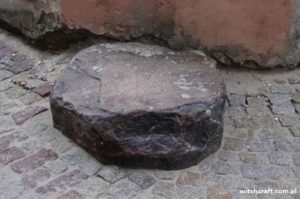 Stone of misery
Stone of misery
Stone of misery is a legendary stone located in the corner of Jezuicka Street, in front of the Trinity Gate. There are a lot of stories about it and it is said to bring bad luck to those who touch it. The stone probably comes from Sławinek, near Lublin. At the beginning of the fifteenth century, it was placed in the Bernardyński Square, the old square of executions. It served as a basis for the trunk of the oak, which was smudged by blood of convicts. Series of misfortunate events began with the beheading of an innocent man by the executioner. The executioner’s ax nicked a deep gap in the stone which is visible till today. Then, the stone was in the Rybny Square. One day, a woman with a dinner for her husband was passing that way. She tripped over the stone and the soup that she was carrying spilled on it. The aroma of the soup attracted dogs that, after having licked the stone, fell dead. Since this event, the square is called Psia Górka (the Dog’s Hill). Another time, the stone blinded a mason who had hit it fiercely. Moreover, during the war, when Germans were bombing the city, the area located in the vicinity of the stone was damaged the most. These and many other misfortunes happened due to the stone of misery. So, maybe it is better to keep away from it.
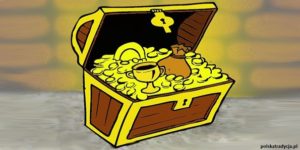 A mysterious treasure
A mysterious treasure
Let’s move in the imagination to the fifteenth century. Polish lands were free and cities ruled by town councilors. God was considered to be the patron of the homeland. Residents of Lublin wanted to build a temple in Lublin in gratitude for his great care. Then, there came Bernardine monks to the city, and the land for the construction of the Bernardine complex was gifted by Jan Kwanta. Quickly, the construction of the temple was initiated. Unfortunately, there lacked the means to complete it, and finding sponsors turned out to be extremely difficult. One windy and stormy autumn night, a mysterious wagon appeared in front of the city hall. It was harnessed with two oxen, but there was no sign of the carter. On the wagon, there was a chest with precious stones and a letter with the command to use the treasures for the construction of the temple. Everyone present during the event was greatly amazed, and after a while, the wagon was gone, as if it dissolved into thin air. This way, thanks to the mysterious treasure, the construction of the church and the monastery could be finished. They can be found in the vicinity of the Wolności Square. The rest of the treasure was hidden in the city hall. You can still see the legendary chest in one of the corridors of the monastery.
 Fable about father Ruszel
Fable about father Ruszel
Father Ruszel was a man of a great mercy and understanding. As a good and pious Dominican, he enjoyed a great respect among the brothers as well as residents of Lublin. Even during his life, he was considered to be saint. After father Ruszel’s death, his body disappeared in mysterious circumstances. Following this event, supernatural phenomena, incomprehensible to humans, started occurring. Father Ruszel’s spirit began to haunt the monastery. With time, the shadow of a human conducting the Holy Mass or playing organ music in Dominican Church no longer surprised anyone.
When, after almost 250 years, the church was occupied by the Russian authorities, one of the soldiers saw a phantom stretching out hands. Without hesitation, he shot towards it and after that, it disappeared behind the wall. At the command of a commission of inquiry the wall was demolished and then, the remains of father Ruszel were found. It became clear that the brothers staged the Dominican’s ascension to raise his virtues. Apparently, the humble soul of father Ruszel wanted to reveal the truth for all those years. Indeed, upon demolition of the wall, the phantom did not appear anymore.
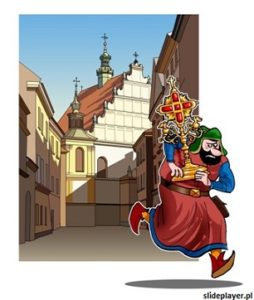
Legend about the reliquary and the thief
The Dominican Church in the Old Town was once famous for its miraculous reliquary with the particle of the Holy Cross. The chapel with the reliquary was visited by crowds of faithful devotees. Once, a merchant Henry from Gdansk arrived to Lublin. He counted on a successful shopping and business contacts. On the question of what to see in Lublin, he received an advice to visit the temple with the miraculous reliquary. When Henry finished his interests in Lublin, he went to the designated church. It was already dark and he was the last visitor in the temple. There came the idea to his mind to secretly deport relics to Gdansk. So, he took the reliquary and set off back home. However, in the vicinity of the city gallows, horses stopped and refused to move forward. Henry turned the wagon fearfully and put the stolen reliquary at its place. At the spot where he turned the wagon, he founded a wooden church. Nowadays, at that place, there is the Academic Church at the John Paul II Catholic University of Lublin.
 About a great delight of Sophia Filipowiczowa performing spells and convicted for witchcraft
About a great delight of Sophia Filipowiczowa performing spells and convicted for witchcraft
Sophia Filipowiczowa was a poor, caring and careful servant of sir Podlodowski in Kozice. Despite the age difference, the woman felt great affection for the landlord, and he also had a weakness for the apprentice. Sophia wanted to keep him with her at all costs. She was constantly searching for help of nearby living witches, and their advices seemed to be effective. Unfortunately, Mr. Podlodowski’s health was progressively declining and he died soon after. The new owner of the farm was his son, John. Sophia was making attempts to attract attention of the young master. However, she was rather unsuccessful. The farm was undergoing various disasters, while Sophia was still trying more and more new magic tricks. John realized that the cause of all the disasters and the death of his father had to do with Sophia and other witches. As a result, the women were finally brought to the court in Lublin and sentenced to torture three times . This met with opposition of clergymen and prominent citizens of Lublin. In the judgment of the court from 1640 one may read: “Filipowiczowa, together with other witches, shall be tortured with rods at pole and bitten, then expelled from the village in the distance of ten miles, and if they appeared again, they would be punished on the throat or the stack.”
 Żmij of Lublin
Żmij of Lublin
Once upon a time, on the hill on which there is the Old Town grew an oak grove. It was a place where Slavs worshiped their gods. One of them was a mysterious and caring Żmij. Those who saw it were saying that it was a reptile with one pair of legs, feet armed with claws, wings and three heads mounted on long necks. He waved with a long snakelike tail covered with scales and ended with a venomous tip. It was believed to be the ruler of vipers guarding justice and taking care of the waters and sowings. Recently, on the street Żmigród, during construction works in the House of Words, there was an extraordinary find made – mysterious sculptures of heads. The place where it happened is located on the hillside sloping down into the valley of Bystrzyca River. These areas have always been called Żmigród, which means the borough of a viper. Apparently, Żmij lived here. The mysterious sculptures are probably heads of this legendary reptile. The image of the Lublin Żmij still adorns the most important monuments of the city.
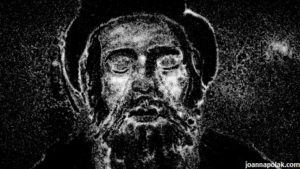 Angel of the Oblivion
Angel of the Oblivion
More than 400 years ago, in Lublin there lived Solomon Luria, called Maharshal – rabbi chief of Lublin and a great scholar of Jewish law. He had a student whose wife died at a young age. The man was mourning after his beloved one by the required seven days, but when the mourning time passed, he was still distraught. Once Maharshal asked about the reason of this sadness. The boy said that just before her death, his wife asked him to promise not to marry again. However, he was still a very young man and he wanted to have a family and children. In his wisdom, the rabbi assured the man that despite the promise made before, he can remarry. Unfortunately, just before the wedding, the man suddenly died. During the funeral Maharshal wrote on a piece of paper: ‘I decide in the name of the Torah, that this man will come back to me,’ and then he signed the letter and put it in hands of the deceased. After the incident, as if nothing had happened, the young man wrapped in a funeral shroud was seen on the streets of the city. However, no woman agreed to marry someone who rose from the grave. Seeing this, Maharshal called the Angel of the Oblivion and asked for blurring the memory about this event in the consciousness of Lublin citizens. Indeed, it happened. The young man eventually remarried. He started a family and his children studied the Torah.
 How was powizytkowski (post-Visitadines) church created?
How was powizytkowski (post-Visitadines) church created?
Day July the 15th 1410 is written in the Polish history very eloquently. It commemorates one of the greatest battles of medieval Europe, the Battle of Grunwald in which the Polish-Lithuanian army gained victory over the Teutonic Knights. The joy of Wladysław Jagiełło, the highest Duke of Lithuania, after winning the battle was so great that he decided to build a church as a votive offering for the success. He came up with the idea to engage the Teutonic Order prisoners locked up in the dungeons of the castle in the construction of the church. In this way, instead of sitting idly, they could do something useful. As it was believed that was Saint Bridget who predicted the collapse of the Teutonic Order, so, after the church had been built, pious and wise Brigettine Sisters were invited there. They came from Gdansk led by the an educated princess Bridget. In the nineteenth century, the sisters went on, and in the monastery of the church, the Visitation Order appeared for a while. Till today, the Rectoral Church of the Assumption of the Virgin Mary Victorious is interchangeably called pogrunwaldzki (post-Grunwald), pobrygidkowski (post-Brigettines) or powizytkowski (post-Visitandines) church.
 How was a great fire made because of pancakes?
How was a great fire made because of pancakes?
It was a beautiful May day of the year 1575. In Lublin, there were preparations for the celebration of St. Stanislaus taking place. Lublin townswomen were cooking, baking and frying, so that everything tasted best, and their husbands were setting up stalls on the streets. The air smelled with lilacs and tasty pastries. After a very busy day, everybody went to bed. Only one townswoman, Jadwiga, was still frying pancakes until late at night. She had a great recipe and thought that the more pancakes she would fry, the more she would sale. However, she could feel the fatigue as well. She did not even notice when she fell asleep while frying pancakes, which not looked after, began to burn. Flames were rapidly spreading, taking wooden houses, tenements, town hall, defensive walls, churches and monasteries. The fire turned out to be extremely difficult to extinguish, and the damage was enormous. However, the residents decided to rebuild the city so that it was even more beautiful. Motivated, they started to work and on-site destruction and created beautiful buildings with multi-colored walls and bas-reliefs in the Renaissance style.
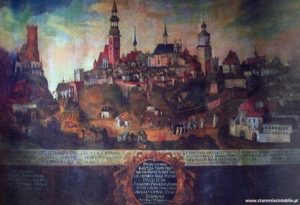 How was Lublin miraculously saved from the fire?
How was Lublin miraculously saved from the fire?
It was the 2nd of June 1719. A terrible storm raged over Lublin. There was a strong wind and lightnings crackled relentlessly one after another. Thus, a stroke of lightning lit up one of the wooden houses in the Jewish quarter in the area of Podzamcze. The fire quickly began to spread in the vicinity of Kowalska Street and then, in the direction of the monastery of Brothers Hospitallers of Saint John of God and the Krakowskie Przedmieście, which caused a great panic among residents. Terrified screams were heard everywhere. In this situation, Lublin Dominicans decided to intervene. The monks took the relics of the Holy Cross and went to the streets, praying devoutly for deliverance of the city from the fire. In fact, lightnings ceased and a pouring rain started, which extinguished the destructive fire. Until today, this event is one of the most famous disasters in the consciousness of Lublin habitants. In the Dominican Church, on the right side of the entrance, there is a painting depicting a wonderfully stopped fire. Unfortunately, famous relics located in Lublin for six hundred years were stolen in 1991 and, to this day, have not been found.


